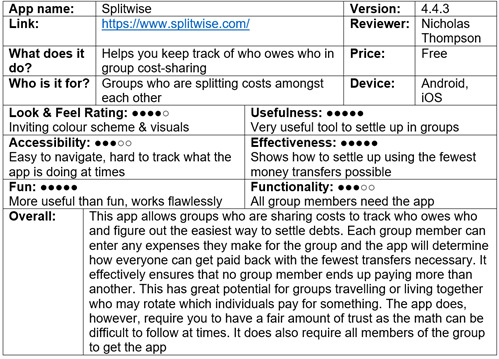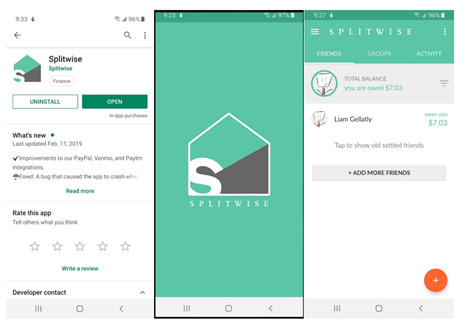Text
Assessment of Sick Kids Hospital’s Use of Social Media
Executive Summary
Sick Kids’ (SK) social media presence is currently split between its Hospital accounts and Foundation accounts. Sick Kids Hospital (SKH) performs much worse across all platforms than the Sick Kids Foundation (SKF), with the exception of Instagram where this is reversed. There is no strong distinction between what these accounts post, despite their different intended audiences. We recommend clearly defining the role of each account, and providing better cross-account linking to improve navigation between them.
Introduction
SKH, located in Toronto, is Canada’s most research-intensive hospital. It provides care to sick children and is dedicated to improving children’s health care. Their social media presence is currently aimed at a mix of parents and employees. The SKF is the fundraising branch of the hospital, and uses social media to help garner donations (Chiovitti, 2017). We have conducted this research to determine ways to improve the organization’s overall social media impact through each of these channels.
Literature Review
The Globe and Mail article “How Traditional Companies are Using Social Media in Unexpected Ways” outlines various options to garner a social media presence and start a conversation (Pearson, 2018). The best social media campaigns are ones that get customers talking about a product, not necessarily selling the product directly (Pearson, 2018). Social media influencer Neil Patel’s blog post on Facebook’s engagement algorithm covers how to better promote your brand on Facebook given changes to how the platform prioritizes content (2017). Crucial is its emphasis on how natural engagements such as comments will help prioritize your content (Patel, 2017). Caitlin Hughes’ blog post on Instagram engagement helps identify several steps to improving one’s Instagram presence (2018). The most relevant steps are her recommendation to craft effective captions that set the context for your photos and the need to reply to comments quickly (Hughes, 2018).
Methodology
This report approached the assessment of SK’s social media performance by analyzing its current presence (posts, videos, and images shared) and determining their effectiveness on each platform. These platforms — Twitter, Facebook, and Instagram — were identified by navigating their website. YouTube was not included in this report due to space constraints. In addition, our process follows social media audit best practices (Hanson, n.d.).
Results
Websites
SK has two websites: SKF and SKH.
The SKF’s website (sickkidsfoundation.com) links to their Facebook, Twitter, and Instagram accounts, as well as the website of the hospital. At the top of every article is a button to Tweet the link, encouraging visitors to share their posts.

Figure 1. The website’s sharing feature.
The SKH webpage (sickkids.ca) links to all social media accounts at the top of the landing page. The site is not responsive to different screen sizes and is inaccessible to users who navigate by keyboard. The website also does not include image descriptions, and many of the images contain writing. This text is unreadable for both visually impaired users as well as search engines, negatively affecting the site’s SEO.

Figure 2. Examples of alt-text, SKH on top and SKF below.
Twitter
SK has two Twitter accounts. The SKH Twitter account (@SickKidsNews) has 12.4k tweets, 38.8k followers and a varied audience of medical professionals, regularly visiting families, and potential donors. The bio links only to their website. The SKF Twitter account (@sickkids) has 22.7k tweets, 49.7k followers, and focuses on donation efforts currently underway. The bio links to both the SKH Twitter page and the Foundation’s Instagram account.
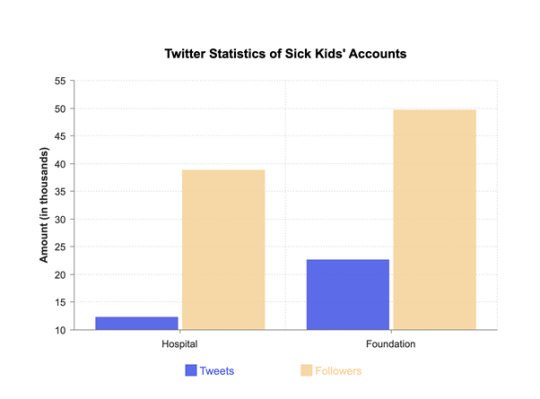
Figure 3. The ratio of tweets to followers on both accounts.
Instagram
SK has two Instagram accounts: a general account with 34k followers (@sickkidstoronto) and a Foundation account with 2.3k followers (@sickkidsVS). Posts occasionally contain excessive text. Both accounts post daily.
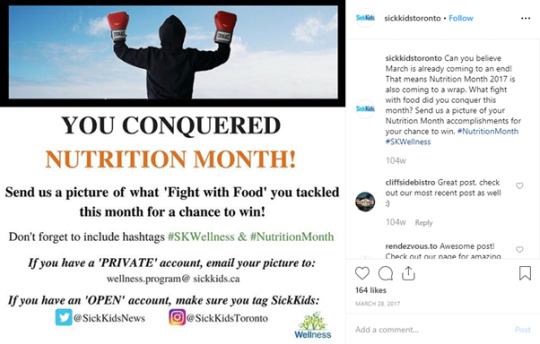
Figure 4. An Instagram post from SK with excessive text.
Facebook
SK has one Facebook account with 193k likes where they post once every few days. The content is mostly pictures and videos. Some of their posts are quite successful, while a significant number lack engagement, particularly those which are recent. Although their content is of high quality, there are instances where it’s cropped poorly or ill-fitting to their brand.
Discussion
Websites
The SKH website should be updated to function across a larger range of screen sizes. It should improve its accessibility features to increase SEO, as well as provide a better experience for disabled users. We suggest following keyboard accessibility standards, adding descriptions to photos, and reducing the amount of text in images (CPD, 2018).
Twitter
We would recommend having pinned tweets to acknowledge the difference between the SKH Twitter account and the SKF Twitter account (Agrawal, 2019). This will encourage individuals to check both accounts and make it easier for the general public to find information about potential donations.
SKH’s Twitter bio should include links to their Instagram and should further refine its target audience to better articulate its message. We recommend focusing exclusively on parents of long-term patients (inspiring stories, advice on handling child illness, etc.) and medical professionals (updates on groundbreaking research). Tweets regarding fundraising would be better suited to the SKF’s account.
Instagram
The @sickkidstoronto account is successfully engaging with the target audience previously outlined. We recommend combining Hospital and Foundation accounts given the latter’s minimal following. Additionally, the captions of some posts should be reworked, better explaining their context and reducing the number of images with excessive text (Hughes, 2018).
Facebook
We would recommend creating posts which play to Facebook’s engagement algorithm by encouraging more comments on a shorter timeline (Patel, 2017). Additionally, SK should refrain from sharing content that is cropped poorly or otherwise undermines their brand.
Conclusion
SKH and Foundation currently have a good online presence. Although there is a slight separation between the branding of the two branches’ accounts (the use of “VS”), they maintain a consistent brand across all platforms. By following our recommendations, SK’s social media can be further leveraged to increase the impact of their social media campaigns. Our recommendations would ensure that they can engage more successfully with their already significant social media following, and increase followers on all sites.
Word Count: 999
Further Reading – List of Direct Links to Sick Kids Social Media Platforms
Sick Kids Foundation website: https://www.sickkidsfoundation.com/
Sick Kids Foundation Twitter: https://twitter.com/sickkids
Sick Kids Foundation Instagram: https://www.instagram.com/sickkidsvs/
Sick Kids Hospital website: http://www.sickkids.ca/
Sick Kids Hospital Twitter: https://twitter.com/SickKidsNews
Sick Kids Hospital Instagram: https://www.instagram.com/sickkidstoronto/?hl=en
Sick Kids Facebook: https://www.facebook.com/sickkidsfoundation/
Sick Kids Interactive Youtube: https://www.youtube.com/user/SickKidsInteractive/
Sick Kids Foundation Youtube: https://www.youtube.com/user/SickKidsFoundation/
AboutKidsHealth Youtube: https://www.youtube.com/user/Aboutkidshealth/
References
Agrawal, S. (2019, February 04). 19 Ways to use Your Pinned Tweet to get More Traffic, sales & clicks! DigitalGYD. Retrieved from https://www.digitalgyd.com/pin-a-tweet-guide/.
Center for Persons with Disabilities (CPD). (2018, November 20). Keyboard Accessibility. WebAIM, Utah State University. Retrieved from https://webaim.org/techniques/keyboard/.
Chiovitti, S. (2017, October 27). SickKids Launches $1.3 Billion Fundraising Campaign to Build a New Hospital. Sick Kids Foundation. Retrieved from https://www.sickkidsfoundation.com/aboutus/newsandmedia/news2017octsickkidscampaignbuildnewhospital.
Hanson, A. (n.d.). How to Conduct a Social Media Audit. ACH Communications and Marketing. Retrieved from https://onq.queensu.ca/d2l/le/content/254144/viewContent/1513524/View.
Hughes, C. (2018, August 29). Increase Your Instagram Engagement in 8 Easy Steps. Iconosquare. Retrieved from https://blog.iconosquare.com/increase-your-instagram-engagement/.
Patel, N. (2017). How to Increase Facebook Engagement (Even Though Their Algorithm Hates You). Neil Patel – Blog. Retrieve from https://neilpatel.com/blog/increase-facebook-engagement-algorithm/.
Pearson, M. (2018, May 12). How Traditional Companies are Using Social Media in Unexpected Ways. The Globe and Mail. Retrieved from https://www.theglobeandmail.com/report-on-business/small-business/sb-marketing/traditional-companies-use-social-media-in-unexpected-ways/article17564456/.
0 notes
Text
Sick Kids Social Media Research Report (Person B Portion)
Audience
I had a different take on who is the audience of the social media accounts. I really feel as though the large majority of content is targeted at donors or potential donors among the general public. Everything from research discoveries to the daily workings of the hospital are promoted on social media in such a way that they share a common thread of compelling people to support the work Sick Kids does. Although explicit tweets about donations may be rare, I really think it is implied on both accounts. Their Twitter bios even say “In campaign to raise $1.3 billion” and “Healthier Children. A Better World.™” respectively. These both present as a focus on marketing and donors. It seems likely to me that medical professionals would be tracking the research done at Sick Kids through other sources which provide greater depth. I also suspect that families with children at the hospital are probably under such stress that social media would be far from their minds. This is just my take, I could be wrong, I would love for us to decide on a final way to proceed as a group. We can decide whether to change the audience listed in the report once we have made a decision as a group.
Suggestions for Improvement
1. Combine their duplicate social media accounts on Twitter and Instagram.
2. Create Facebook content which encourages comments to create natural engagements and promotion.
3. Create Instagram content which requires reading less text to be understood.
Additional Strengths
- The production quality of their content. For example, their videos are cinema quality ads.
- They conduct themed campaigns such as their Sick Kids VS campaign to provide fresh interest and build continuity.
REPORT
Assessment of Sick Kids Hospital’s Use of Social Media
Executive Summary
This section will generally outline our findings once we have finalized our report.
Introduction
Sick Kids Hospital is located in Toronto, Ontario and is Canada’s most research-intensive hospital. It provides care to sick children and is dedicated to improving children’s health care. The hospital integrates aspects such as teaching and research to provide the utmost patient care. The Sick Kids Foundation, the fundraising branch of the hospital, is currently fundraising to build a new facility to dramatically improve patient care. Sick Kids Hospital is providing a necessary service, but they cannot do this without generous donations, and using social media can help with this problem. This research is being conducted to determine ways to improve the organization’s overall social media impact and increase potential fundraising capabilities.
(We should cite some of this information – do we know where it was originally pulled from?)
Literature Review
The Globe and Mail article “How Traditional Companies are Using Social Media in Unexpected Ways” outlines various options to garner a social media presence and start a conversation (Pearson, 2018). As the article highlights, some of the best social media campaigns are ones that get customers talking about a product, not necessarily directly trying to sell it to them outright (Pearson, 2018). Social media influencer Neil Patel’s blog post on Facebook’s engagement algorithm covers how to better promote your brand on Facebook given recent changes to how the platform prioritizes content (2017). Crucial is its emphasis on how natural engagements such as comments will help prioritize your content (Patel, 2017). Social media influencer Caitlin Hughes’ blog post on Instagram engagement helps identify several concrete steps to improving one’s Instagram presence (2018). The most relevant steps for this report are her recommendation to craft effective captions that set the context for your photos and the need to reply to comments quickly (Hughes, 2018).
Methodology
This report approached the assessment of Sick Kids’ social media by analyzing its social media presence (posts, videos shared, images shared, etc.) and determining the effectiveness of these various characteristics on each platform. These platforms include Twitter, Facebook, and Instagram, which each have different content creation requirements in order to present effective outreach. These platforms were identified by navigating their website and determining the extent of their social media presence. YouTube was excluded from our final analysis as Sick Kids seems to treat it as a place to simply upload their video content online rather than engage with users. This process overall generally falls in line with best practices for social media audits (Hanson, n.d.).
Results
Twitter
The Sick Kids Hospital twitter account has 12.4k tweets with 38.8k followers. These tweets are extremely varied and do not cater to a specific category of individuals or audience. The main categories are: physicians interested in upcoming events and current medical findings, families who are currently visiting Sick Kids regularly, and general public. The only tweet referencing the new facility in need of donations was 12 days old at the time of writing the report. The Sick Kids Foundation twitter account has 22.7k tweets and 49.7k followers. It is the main platform for fundraising of the Hospital and has many tweets referencing donation efforts currently underway. The Twitter link on the Sick Kids Hospital main website takes users to the Sick Kids Hospital Twitter account and does not reference the Sick Kids Foundation Twitter page on either the main website or the Sick Kids Hospital Twitter page.
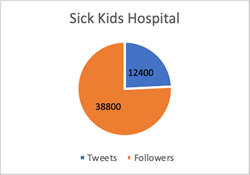

Figure 1. An examination of the ratio of tweets to followers on both accounts.
Instagram
Sick Kids has two Instagram accounts – their general one with 34k followers and their VS campaign one with 2.3k followers. A lot of the content on both platforms is rather personal showing hospital staff or patients. This sometimes leads to situations where users are presented with an image difficult to understand without context. There are also times where images contain excessive text, something less than ideal for an image driven platform. Posts appear daily on both accounts.

Figure 2. An example of an Instagram post from Sick Kids with excessive text.
Facebook
Sick Kids has one Facebook account with 193k likes where they post once every few days. The content is mostly pictures and videos. Some of their posts are quite successful but there are a significant number of posts with no comments, especially those which are recent. Although their content presents as relatively high quality there are some instances where it is cropped poorly or is ill-fitting to their brand.

Figure 3. A VS campaign video shared on their Facebook account with content questionable for a children’s hospital.
Discussion
Twitter
We would recommend having a pinned tweet to acknowledge the difference between the Sick Kids Hospital twitter account and the Sick Kids Foundation twitter account (Agrawal, 2019). This will encourage individuals to check both accounts and make it easier for the general public to find information about potential donations.
Instagram
We would recommend combining the accounts given the second account’s minimal follow. Additionally, it would be beneficial to better target their captions to ensure context is better explained and there are fewer images with excessive text (Hughes, 2018).
Facebook
We would recommend creating posts which play to Facebook’s engagement algorithm by encouraging more comments on a shorter timeline (Patel, 2017). Additionally, Sick Kids should reconsider branding guidelines on what content is acceptable to share in relations to a children’s hospital even if it’s for the sake of marketing.
Conclusion
Sick Kids Hospital and Foundation have a good online presence currently and it can be further leveraged to increase the impact of their social media campaigns, by following some of our recommendations. Our recommendations would ensure that they can engage better with their already significant social media following.
Further Reading – List of Direct Links to Sick Kids Social Media Platforms
https://twitter.com/SickKidsNews
https://twitter.com/sickkids
https://www.instagram.com/sickkidstoronto/?hl=en
https://www.instagram.com/sickkidsvs/
https://www.facebook.com/sickkidsfoundation/
References
Agrawal, S. (2019, February 04). 19 Ways to use Your Pinned Tweet to get More Traffic, sales & clicks!. DigitalGYD. Retrieved from https://www.digitalgyd.com/pin-a-tweet-guide/.
Hanson, A. (n.d.). How to Conduct a Social Media Audit. ACH Communications and Marketing. Retrieved from https://onq.queensu.ca/d2l/le/content/254144/viewContent/1513524/View.
Hughes, C. (2018, August 29). Increase Your Instagram Engagement in 8 Easy Steps. Iconosquare. Retrieved from https://blog.iconosquare.com/increase-your-instagram-engagement/.
Patel, N. (2017). How to Increase Facebook Engagement (Even Though Their Algorithm Hates You). Neil Patel – Blog. Retrieved from https://neilpatel.com/blog/increase-facebook-engagement-algorithm/.
Pearson, M. (2018, May 12). How Traditional Companies are Using Social Media in Unexpected Ways. The Globe and Mail. Retrieved from https://www.theglobeandmail.com/report-on-business/small-business/sb-marketing/traditional-companies-use-social-media-in-unexpected-ways/article17564456/.
0 notes
Text
Twitter Essay on Search Engine Optimization
1. Searching Engine Optimization or #SEO for short is the practice of designing your #website so that it’s more easily retrievable from search engines like @Google. This is key as search engines are how 91% of people access the internet.
2. Now you may be asking – how do I use #SEO for my site? The answer is simple – carefully curate the language used by and the reach of your #website. This will ensure your site appears earlier in search engine results.
3. Beginning with language – you must think of all the different terms someone could search related to the topic of your site. Doing #SEO for your sunglasses store? Your site should probably include the words sun and glasses too. #keywords
4. Moving to reach – you must ensure your #website is #backlinked or in other words referred to via #URL by many other sites. Your #SEO needs this to be prominent sites too. Get links on influential platforms like @facebook or @Twitter.
5. Remember that #SEO requires your site to stay up to date. Search engines are constantly checking your #keywords and that you’re #backlinked to provide searchers with organic listings or in simpler terms, the best results possible.
6. Stuck on how to effectively implement #SEO on your site? There’s no need to reinvent the wheel – the web has many examples of how to do this well. Check out the following article for some inspiration: https://tinyurl.com/yy4e8puv
7. To conclude, #SEO requires that you make use of #keywords and being #backlinked to ensure your page comes up in the crucial top 3 of search engine results. This will give your #website more of its ideal viewers.
8. Do I have any afterthoughts? I would be remiss not to use this opportunity for #SEO on my own blog. Check it out at: https://writ240nick.tumblr.com/
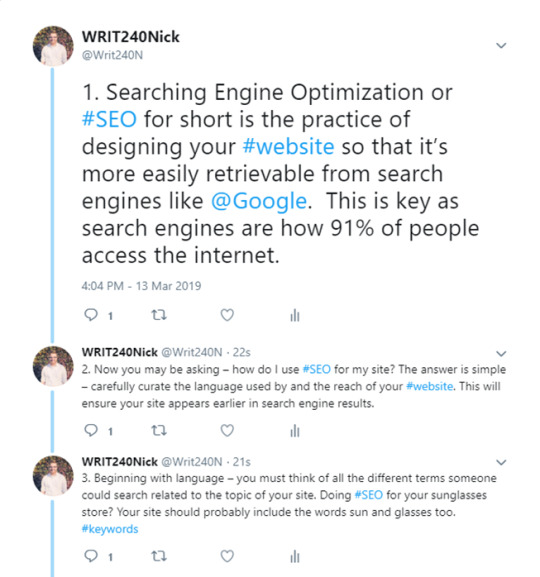
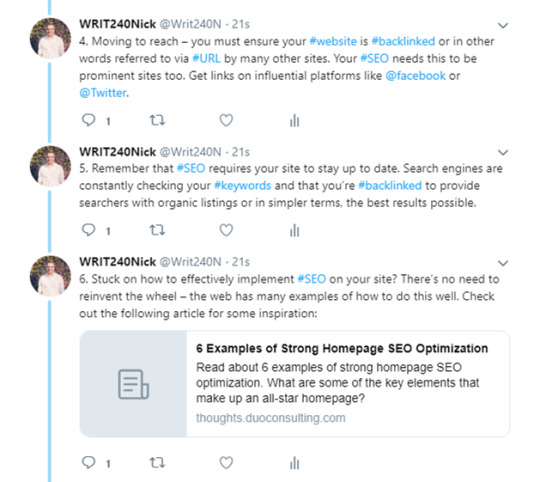

0 notes
Text
It Tastes Good Because It Is Good
Introducing XOXO, a chocolate company where we strive not only to make better chocolate but also a better world. Among the best available on the market, our chocolate is both made with real ingredients and sustainably sourced. With these factors in mind, we hope you let us introduce you to a classic treat with our modern twist.

Real Ingredients
With health in mind, our product is not only GMO-free but also free of sweet additives such as soy, gluten or corn. This means you can indulge knowing that good health can also include a healthy dose of good chocolate. You can also rest assured of our genuine guarantee – naturally good chocolate made solely of naturally made ingredients.
Sustainably Sourced
Each bar of chocolate is sourced from farmers earning fair wages located in the temperate Peruvian Valley. This is part our commitment to ensure every treat you give yourself also gives backs to local communities. You can purchase our product knowing that each bite supports ethical practices and fair-trade solutions.

If none of this has sold you yet, trust in the fact that the use of real and sustainably sourced ingredients has come at no additional cost to you. In short, our passion is helping you stay healthy while helping the world stay healthy as well. Each purchase of XOXO lets you enjoy some of the world’s finest chocolate without the need for calling it a guilty pleasure. Whether you’re looking to better yourself or better the world, we hope you look for us next time you crave a treat.

0 notes
Text
An Introduction to Canadian Politics

Why Should I Care?
Politics has different meaning and significance for every Canadian. To some it’s simply a headline they skim in the news, to others it’s a full-time career. No matter if you’re a political junkie or couldn’t care less, it’s worth understanding politics as the resulting decisions can impact your day to day life significantly.
The Basics
Let’s start with those of you completely unfamiliar with Canadian politics. Everyone in Canada belongs to one of 338 electoral districts, more commonly referred to as “ridings”, which are determined based on geography. Every 4 years Canadians vote to decide who their respective riding’s representative in Parliament will be, more commonly referred to as a “Member of Parliament”. Parliament for those of you who don’t know is the body which makes decisions surrounding the future of laws and structure of government in Canada. Each candidate for Member of Parliament tends to be affiliated with a political party and this in large part influences who gets elected. There are many political parties in Canada with some major ones such as the Conservative Party, Liberal Party, New Democratic Party, and Green Party standing out. Much could be written about each of these parties and I highly recommend further research to determine which one might best represent you.

Next Steps?
Now let’s move to more advanced material for those of you well acquainted with Canadian politics or those who wish to learn more. Aside from watching the news, the next step to furthering your knowledge of Canadian politics is getting involved. Each party has what is known as an “Electoral District Association” for each riding which organizes and campaigns for that party in that riding. Contacting the relevant Electoral District Association in your riding is very likely the best way to get involved and learn more. They can often be reached simply by registering online for the political party you are interested in.
My Story
Now you may be wondering, what qualifies me to talk about this? I first became involved in Canadian politics when a high school teacher introduced me to a local political candidate. I have spent the past 6 years involved heavily in numerous election campaigns and Electoral District Associations. This inspired me to pursue a degree in political studies at Queen’s University and further my knowledge on the subject as much as possible.
Using Social Media
One of the best ways to learn more about the current events in Canadian politics is to get on social media platforms such as Facebook or Twitter. Facebook frequently serves as a platform for Canadian political parties to engage users and recruit membership. Twitter frequently serves as a forum for discussion on numerous issues in Canadian politics with almost every Member of Parliament having an account. In short, social media serves as a platform for discussion of and engagement on the most pressing issues facing Canadian politics.

1 note
·
View note
